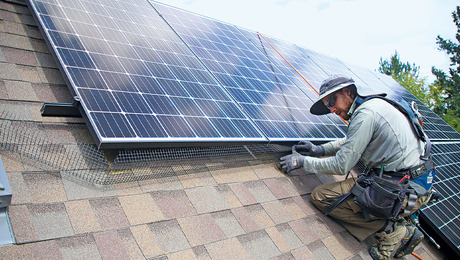
Reports on energy use in large Boston office buildings show those built before 1950 used “significantly less” energy per square foot on average than buildings constructed after 1950. Offices buildings with the lowest energy use per square foot are a century old.
That’s one finding in a report published in August by the city’s Environment Department and the Air Pollution Control Commission. It sums up energy and water use in 820 non-residential buildings of 50,000 sq. ft. or more, part of an expanding city effort to trim greenhouse gas emissions.
Boston used a number of metrics to compare energy use among different types of buildings. One is site energy use intensity (EUI), which is the sum of all energy used by the building divided by the gross floor area (reported as thousands of Btus per square foot per year). With that yardstick, office buildings constructed in the 1970s and 1980s showed the highest EUIs, hitting 95 kBtu/sq. ft./yr. in offices constructed during the ’70s and climbing to more than 100 in the following decade.
Although the total square footage of office buildings built prior to 1950 is much lower than in later decades, so were the EUIs. For offices built in the 1930s and ’40s, for example, the EUI was roughly 45 kBtu/sq. ft.; in office buildings constructed in the 1910s, the median EUI was as low as about 40.
By the 1990s, EUIs had dropped steeply, to about 50 kBtu/sq. ft. In the following decade and beyond, the median EUI was rising once again, to roughly 65 kBtu/sq. ft. But the energy use per floor area of the newest buildings is still much higher in buildings at least a century old.
The reason? Glass curtain walls.
“In analyzing their reported energy data, New York and Seattle found similar patterns of EUI by building age,” the report notes. “Much of this variation is due to changes over time in construction materials and building systems: pre-WWII buildings tended to use masonry construction, for example, compared to glass-curtain wall construction in the 1960s and 1970s.”
Other results
The report breaks down the percentage of energy consumption and greenhouse gas emissions in different types of buildings. Three types of buildings–offices, hospitals, and colleges and universities–accounted for two-thirds of all greenhouse gas emissions in the city. But even within certain building types there are wide swings in EUI–in some cases, the most energy-intensive buildings used 10 times as much energy per square foot as the least energy-intensive, the report said.
Here are some other findings:
- Owners of some types of buildings had a high compliance rate for filing the required information while others didn’t seen to care as much. For example, buildings used for higher education showed a 94% compliance rate; laboratories were 100% compliant; health care buildings were 86% compliant. Retail buildings posted a 44% compliance rate, private schools only 41%.
- The bigger the building, the better chance the owner would report energy and water use. Buildings from 500,001 to 600,000 sq. ft. were 100% compliant. Buildings from 50,000 to 100,000 sq. ft. were 61% compliant.
- Laboratories reported the highest site EUI by building type, followed by offices, colleges/universities, and hospitals.
- Median Energy Star scores are well above the national median for certain types of buildings (offices, financial offices, and dorms) and lower than the national median for others (hospitals and medical offices). The reasons for differences across different building sectors isn’t understood.
- Offices and hospitals together use more water than any other building type 23% and 22% respectively. Those two categories also accounted for the highest greenhouse gas emissions.
The city hopes that sharing information about water and energy use will help building owners find ways to economize. In May, large residential building owners began reporting energy and water use as commercial, industrial and institutional buildings reported a second year of data. Reporting on energy and water use for buildings between 35,000 and 50,000 sq. ft. begins next year.
Because the information is public, residential and commercial tenants will be able to look up energy and water use and greenhouse gas emissions for the buildings they either live in or work in.
“Increased awareness of energy use and costs will spur conversations between owners and tenants about reducing energy use and will enable stakeholders to consider this information in their decision making,” the report says.
Boston is one of a number of cities around the country with energy reporting requirements, including New York; Philadelphia; Seattle; San Francisco; Washington, D.C.; Austin, Texas; and Minneapolis, Minnesota.
Read more: http://www.greenbuildingadvisor.com/blogs/dept/green-building-news%2A#ixzz3p8S2718H
Follow us: @gbadvisor on Twitter | GreenBuildingAdvisor on Facebook
Fine Homebuilding Recommended Products
Fine Homebuilding receives a commission for items purchased through links on this site, including Amazon Associates and other affiliate advertising programs.

Handy Heat Gun

Reliable Crimp Connectors

Affordable IR Camera

Many large, nonresidential buildings in Boston earn high Energy Star scores. Offices, university dorms and public school buildings all have median scores that are significantly higher than the national median, according to a new report.



























View Comments
Really sharing a valuable information about energy use . This blog help to find ways how to economize energy.